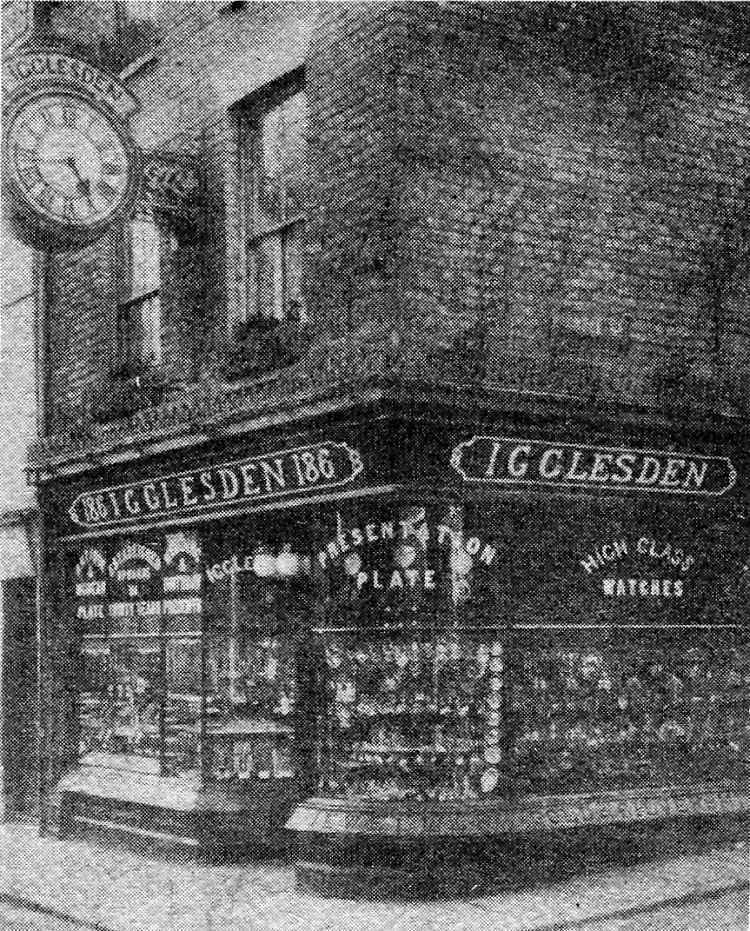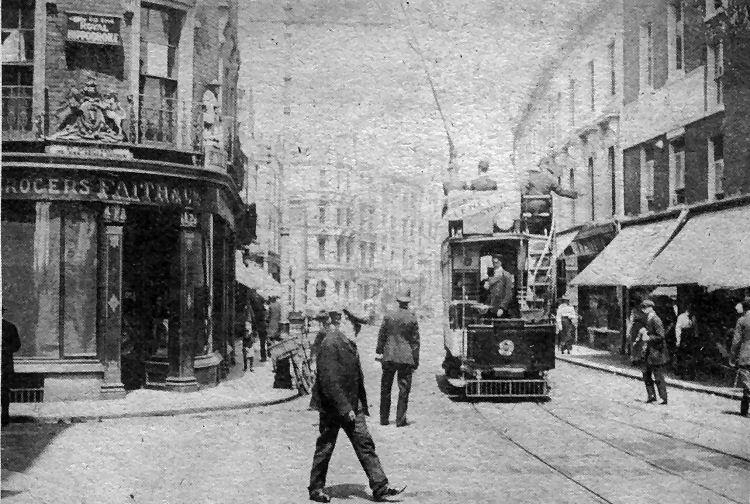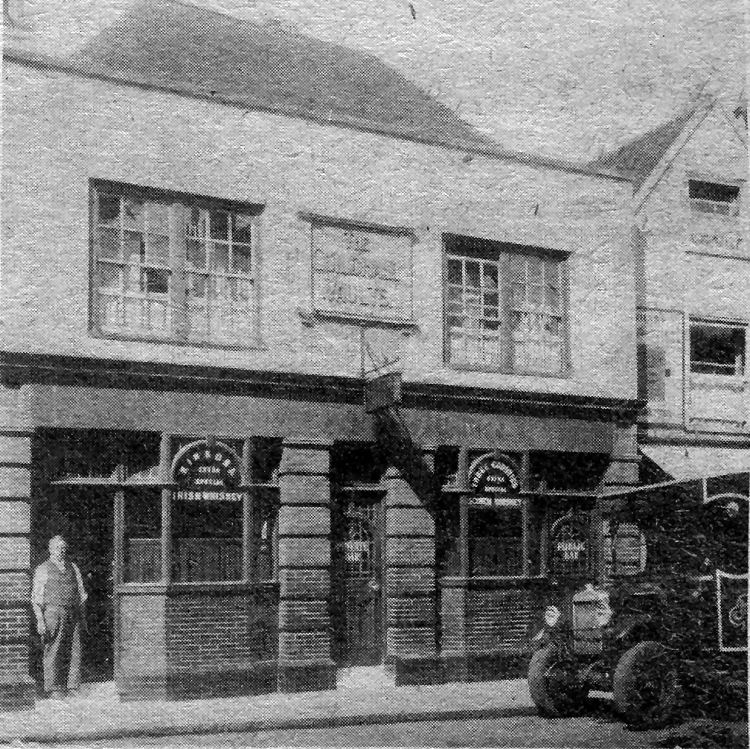Page Updated:- Sunday, 07 March, 2021. |
|||||
 Published in the South Kent Gazette, 12 September, 1979. A PERAMBULATION OF THE TOWN, PORT AND FORTRESS. PART 24.
A NEWSPAPER STREET. The section of Snargate Street from Chapel Street to the site of the gate suggests several points of interest. Snargate Street clock was a familiar feature of this part of the street for more than 40 years prior to 1908, projecting from Igglesden’s, the clockmaker’s, between the old Dover Express office and Chapel Street.

Another business run by one of the Igglesdens, in the 1890s, was the jewellers and silversmith business which stood on the corner of Chapel Street and Snargate Street. The clock was a popular landmark. Next door, on the left, were the old offices of the Dover Express which, before the buildings were demolished, subsequently took over the corner shop which for many years was a chemists.
Once Snargate Street was “the Fleet Street“ of Dover. Here was published, at No. 66, Dover’s first newspaper, the Cinque Ports Herald, in the year 1825. Dover’s next newspaper venture, the Dover Telegraph, originated at Batcheller’s Library, at the top of the street, in the year 1833. The Dover Express began its existence in this street, at No. 133, in 1858. The new paper proved a success and the following year moved to larger premises at No. 185 Snargate Street where it remained for 110 years. Also in Snargate Street were the offices of the Dover Standard, from 1878 to 1931; and for some years the Dover Observer was published at No. 144, and later the Dover Times. In this street, also, at the Albion Library, 86, Snargate Street, “The Historical Sketch of the Town of Dover“ was published in the year 1799, by G. Ledger; and, later, from the same printing office, Lyon’s History of Dover. The Newspaper Street era came to an end when Ministry of Transport plans to take the York Street dual carriageway through the Dover Express offices and adjoining properties forced the printing works to be closed down. The Dover Express then moved to offices in Castle Street but production of the paper was switched to Folkestone and Hastings.
ANCIENT DEEDS. The earliest deed we can trace, touching property in this upper part of the street, is dated the 25th July, 1362. The deed relates to a tenement and its appurtenances in Snargate Ward, and judging from the bearings given of the lands and roads surrounding, it might possibly have been the top corner of Snargate Street, extending down to Chapel Street. This deed was witnessed by the mayor and members of the corporation, but the parties to it were the transferers and transferees of the property. The two points of interest about this deed are that it relates to property in Snargate Ward prior to the erection of the gate further down the street, afterwards called Snar Gate, and it discloses a lordship apart from the corporation. The next deed relating to Snargate Street property is dated 1st September, 1473, and is an indenture between the Mayor and Commonalty and John Fuller, conveying to him a vacant plot of land having the land of John Frewin above it, the land of Thomas Goore below it, and the King’s Highway — which would be Snargate Street — to the south-east of it. The size of the plot is not defined, but the rent is 6d. per year, subject to the port service due to the King, with the right of the corporation to re-enter if the rent or service were not paid. This deed discloses to us the north-west side of Snargate Street, immediately below Chapel Street, being exploited as a building estate in the year 1473. Another deed, dated 20th September, 1513, between the Mayor and Commonalty and Robert Fluce, conveyed to the latter “one plot of building land next a certain gate called Snar Gate.“ This deed, which is on the same terms as the former, testifies to the fact that as late as the year 1513 the land on the inside of the gate was still building land. From an endorsement on the deed of 1473, it appears that this Robert Fluce subsequently acquired Fuller’s land. If there were more of these deeds they would be interesting, but the three quoted throw light on how and when Snargate Street was developed.
THE NAME “SNARGATE.“ It will be of interest to turn now to the question of how Snargate Street obtained its name. Some have asserted that the street derives its name from the gate, but, if true, that only leads us on to the next question: “How did the gate obtain its name?“ Evidently Snar Gate, built about 1370, did not originate the name, because there was a Snargate Ward prior to that time; nor was there anything in the position or construction of that gate to suggest its name. To find its origin we must seek further back. The word naturally suggests a snare, which is a mechanical device to catch something. Bearing in mind how the mouth of the Dour was originally blocked up by the mud and rubbish carried down it, and how, later, the great standing water into which the western branch of the Dour emptied, began to fill up by the same agency, it may be imagined that the engineers of that period might have devised a sort of grating across the stream to catch the rubbish as it came; and a natural name for such a contrivance would be a “Snargate,“ especially if, in the part of the wall under which the stream ran, there was inserted a gate to afford facilities for maintaining and clearing the grating. Such a contrivance might have existed at an early period, and that would account for the name Snargate being applied to the ward long before the Snar Gate of 1370 was built. The street improvers of 1834 had in their minds to widen the upper part of Snargate Street on the north side. At the top corner at that time stood the chemist’s shop of Mr. James Stable Neales, and next below him in Snargate Street was Mr. Cloke’s bakery, both left untouched when Bench Street was widened. They were sold by auction in 1836, and were purchased by Mr. Page, who was then carrying on a grocery business at No. 5, Bench Street. The corner remained unimproved until 1840, when Mr Page entirely rebuilt the block from the “Shakespeare“ in Bench Street as far as the lower side of Hart and Co’s former furniture shop in Snargate Street. Previous to the rebuilding, Mr Page approached the Paving Commissioners, in the early part of 1840, stating that for a sum of £300 he would set back the frontage of his buildings in Snargate Street three feet.

AN EARLY open-top tram trundles its way along Bench Street on its journey
to Buckland at the turn of the century. It was an age when one could amble
across the street at one’s leisure. On the corner on the left a sign directs
theatre-goers to the "Royal Hippodrome" theatre in Snargate Street. The
building was for many years the premises of Page, the grocer and a royal
coat of arms proclaims “By appointment to H.R.H. Prince Arthur." Another
interesting feature is a statue at first floor level of a Chinese coolie.
Faith & Co. had taken over the business when the picture was taken. Opposite
were the premises of A. and G. Pipe, milliners and drapers, Frederick
Martin, military tailor and H. H. Ford “hosier, hatter, glover and shirt
maker.“ 
The picture, above, taken about 1928, shows the "Guildhall Vaults" and J. Williams, the tobacconists on the corner of Bench Street and Queen Street.
|
|||||
|
If anyone should have any a better picture than any on this page, or think I should add one they have, please email me at the following address:-
|
|||||
| LAST PAGE |
|
MENU PAGE |
|
NEXT PAGE | |